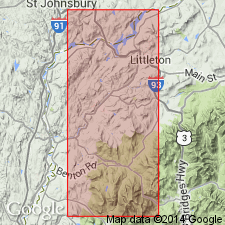
- Usage in publication:
-
- White Mountain petrogenic cycle
- Modifications:
-
- Original reference
- AAPG geologic province:
-
- New England province
Summary:
Four major periods of intrusive igneous activity have been recognized in central New Hampshire: The Highlandcroft, Oliverian, New Hampshire, and White Mountain petrogenic cycles.
The Highlandcroft cycle includes diorite, quartz diorite, granodiorite, and granite. They are younger than Partridge slate and older than Clough conglomerate; are definitely pre-Silurian, and probably late Ordovician.
The Oliverian rocks are largely biotite granite; younger than [Early] Devonian but older than major period of orogeny.
The New Hampshire magma series consists of diorite, quartz diorite, granodiorite, trondhjemite, and granite, younger than [Early] Devonian and essentially contemporaneous with the great period of folding.
Youngest of all is White Mountain ("alkaline") magma series, which is younger than [Early] Devonian, and later than the period of orogeny.
Thus 3 of the igneous series are younger than [Early] Devonian, and to them belong 90 percent of the igneous rocks of central New Hampshire. The other 10 percent (the Highlandcroft group) is pre-Silurian, probably late Ordovician but possibly older. On 1932 geologic map of US only the White Mountain magma series is shown as Paleozoic; all others being included in pre-Cambrian. In other words, Paleozoic intrusives are much more abundant than map shows. [Billings mapped New Hampshire magma series and Highland Croft magma series over parts of Littleton and Moosilauke quadrangles in Amer. Jour. Sci., 5th ser., v. 28, Dec. 1934, p. 414.]
M. Billings (letter dated July 19, 1935) stated "There is no one type locality for White Mountain magma series. It refers to a group of comagmatic igneous rocks that are exposed all over central and northern NH. If there must be a type locality it would be the North Conway 15-min quadrangle, northern NH.
Source: US geologic names lexicon (USGS Bull. 896, p. 2323, Highland Croft entry p. 955).
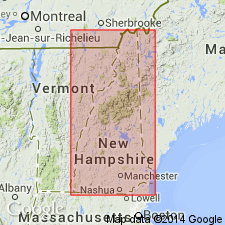
- Usage in publication:
-
- White Mountain Plutonic-Volcanic Series*
- Modifications:
-
- Age modified
- Geochronologic dating
- AAPG geologic province:
-
- New England province
Summary:
Page F2 states that the White Mountain Plutonic-Volcanic Series has an age of Late Triassic or Early Jurassic. Isotope age determination by Tilton and others (1957) and Hurley and others (1960) yields an age of 180 m.y. [It is unclear how 180 m.y. translates into Late Triassic or Early Jurassic. The ages of the Conway Granite, Mount Osceola Granite, Mount Lafayette Granite Porphyry, Mount Garfield Porphyritic Quartz Syenite, and the Albany Quartz Syenite are inferred to be Late Triassic or Early Jurassic.]
Source: GNU records (USGS DDS-6; Reston GNULEX).
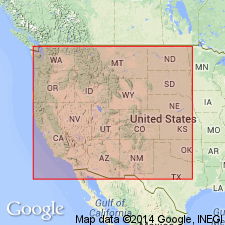
- Usage in publication:
-
- White Mountain Plutonic-Volcanic Series*
- Modifications:
-
- Geochronologic dating
- AAPG geologic province:
-
- New England province
Summary:
Pg. 24, geologic time scale (inside front cover). White Mountain Plutonic-Volcanic Series. Syenite sample from Harts location, Crawford Notch quadrangle, Carrol County, New Hampshire, yielded a Pb-alpha age of 180 +/-20 Ma (zircon) [Jurassic]. Age in agreement with Rb-Sr ages (biotite) from Conway Granite (Foland and Faul, 1977, Amer. Jour. Sci., v. 277, p. 888-904). Ages calculated using decay constants of Steiger and Jager, 1977 (Earth Planet. Sci. Letters, v. 36, p. 359-362).
Source: Publication.
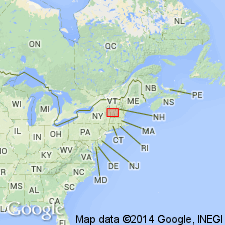
- Usage in publication:
-
- White Mountain Plutonic-Volcanic Suite*
- Modifications:
-
- Areal extent
- Age modified
- Geochronologic dating
- AAPG geologic province:
-
- New England province
Summary:
Rocks representing the White Mountain Plutonic-Volcanic Suite are found in the Glens Falls quad at Cuttingsville, VT (Cuttingsville stock), and Mount Ascutney, VT (Ascutney stock). Both stocks are composed largely of syenite or quartz syenite, with some nepheline syenite at Cuttingsville. Radiometric studies (K-Ar method) by Armstrong and Stump (1971) and Foland and Faul (1977) yield ages of 100 and 120 Ma, respectively, for Cuttingsville and Ascutney stocks.
Source: GNU records (USGS DDS-6; Reston GNULEX).
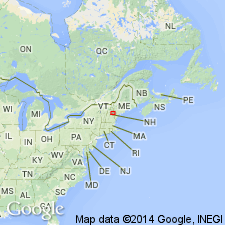
- Usage in publication:
-
- White Mountain igneous province
- Modifications:
-
- Geochronologic dating
- AAPG geologic province:
-
- New England province
Summary:
White Mountain igneous province; subunits also treated informally. Reported radiometric dates are as follows:
1. Mount Garfield porphyritic quartz syenite, K-Ar on amphibolite, 193 +/-6 and 201 +/ 6 Ma.
2. Mount Lafayette granite porphyry, K-Ar on amphibolite, 195 +/-6 Ma.
3. Albany porphyritic quartz syenite (northern ring dike), K-Ar on biotite, 179 +/-5 Ma.
4. Albany porphyritic quartz syenite (southern ring dike), Rb-Sr whole rock isochron, 170.3 +/-0.4 Ma
5. Conway granite, K-Ar on biotite, 183 +/-5, 182 +/-4, 180 +/-4 (two samples), 178 +/-4, 171 +/-4, and 155 +/-4 Ma.
6. Mount Osceola granite, Rb-Sr whole-rock isochron, 186.6 +/-1.2 Ma.
7. Mount Carrigain complex, Rb-Sr whole-rock isochron, 193.0 +/-2.1 Ma.
8. Moat volcanics, K-Ar whole rock on trachyte from Moat, 169 +/-4 and 162 +/-4 Ma; Rb-Sr whole rock isochron, 173.1 +/-1.5 (lower part of Moat), and 168.2 +/-1.2 (upper part of Moat) Ma.
Source: GNU records (USGS DDS-6; Reston GNULEX).
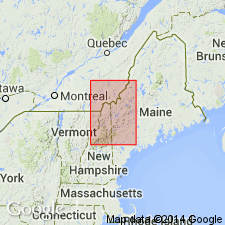
- Usage in publication:
-
- White Mountain Plutonic-Volcanic Suite*
- Modifications:
-
- Age modified
- Geochronologic dating
- Overview
- AAPG geologic province:
-
- New England province
Summary:
White Mountain Plutonic-Volcanic Suite includes rocks mapped as the New England-Quebec igneous province, Eastern North America dolorite province, and White Mountain magma series province of McHone and Butler (1984). Although the overall age for the White Mountain Plutonic-Volcanic Suite spans the Mesozoic, there are no Triassic rocks in this map area. Jurassic rocks include Conway Granite and Conway-type granite, intrusive rhyolite of Gay Brook ring dike, Mount Osceola Granite, leucocratic granite to quartz syenite; hornblende granite porphyry (including Mount Lafayette Granite Porphyry); riebeckite granite; hastingsite or ferrorichterite quartz syenite; porphyritic hornblende quartz syenite (including Mount Garfield and Albany Porphyritic Quartz Syenites); hornblende-biotite quartz monzodiorite, quartz monzonite, and diorite; hornblende-biotite quartz diorite, hornblende or ferrorichterite syenite and quartz syenite; porphyritic hornblende syenite; hornblende-biotite diorite; olivine-augite gabbro; and Moat Volcanics. Early Cretaceous or Jurassic rocks include a basalt plug at Red Ridge, and diorite or gabbro plugs or dikes near Bridgton. Early Cretaceous rocks include porphyritic hornblende-biotite syenite and trachyte at Pleasant Mountain; porphyritic biotite granite, hornblende-biotite syenite, and gabbro-diorite at Megantic Mountain. Isotopic dates are cited for most of the rock bodies as reported by other workers, particularly Randall and Foland (1976), Foland and Faul (1977), Foland and others (1986), and Eby and others (1992). [See also entry under Lyons and others (1997) for detailed information on isotopic data.] Time scale of Harland and others (1989) was followed. Report includes geologic map, cross sections, and correlation chart.
Source: GNU records (USGS DDS-6; Reston GNULEX).
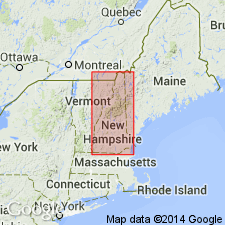
- Usage in publication:
-
- White Mountain Plutonic-Volcanic Suite*
- Modifications:
-
- Overview
- Geochronologic dating
- AAPG geologic province:
-
- New England province
Summary:
Includes Cretaceous alkalic syenite to granitic to gabbro plutons, minor volcanic rocks, and lamprophyre dikes of New England-Quebec igneous province of McHone and Butler (1984); and Jurassic granite and syenite, and less abundant quartz syenite, diorite, gabbro, nepheline syenite, and volcanic rocks of White Mountain igneous province of McHone and Butler (1984). Triassic rocks not shown. 1:250,000-scale map includes 21 mappable bodies. Formal units include Middle Jurassic(?) Moat Volcanics, Early and Middle Jurassic Mount Osceola Granite, and Late(?) and Middle Jurassic Conway Granite. Late Triassic(?) and Early Jurassic Mount Garfield Porphyritic Quartz Syenite and Albany Porphyritic Quartz Syenite combined as part of an unnamed quartz syenite unit [Late Triassic age is too tentative to use on correlation chart or for range of ages of White Mountain rocks in NH.]. Includes a unit of rhyolite and fine-grained granite, a unit of quartz syenite porphyry, and a unit of massive to porphyritic black basalt all previously mapped as Ossipee Mountain Complex of Kingsley (1931), a name not used on this map. Isotopic age data (in Ma; shown on accompanying 1:500,000-scale map of plutons) are as follows:
1. Gore Mountain granitic intrusive rocks: 169 +-3 K-Ar (Foland and Faul, 1977).
2. Pliny Range intrusive rocks: 182 +-4 and 189 +-5 K-Ar (Foland and Faul, 1977); 183 +-2 Ar/Ar (Randall and Foland, 1986).
3. Cannon Mountain pluton: 184 +-4 K-Ar (Foland and others, 1971); 194 +-4 K-Ar (Foland and Faul, 1977).
4. Conway Granite: 188 +-5 U/Pb (Tilton and others, 1957); 177 Rb/Sr biotite (Aldrich and others, 1957); 180-134 Rb/Sr biotite (Aldrich and others, 1958); 173 +-8 Rb/Sr biotite (Hurley and others, 1960); 181 +-4 K-Ar (Hurley and others, 1960); 169 +-3 K-Ar (Foland and others, 1971); 169 +-3 K-Ar and 181 +-4 K-Ar (Foland and Faul, 1977); 196, 193, 186, and 175 Rb/Sr biotite and 185 Pb/Pb (Eby and Creasy, 1983); 183 +-5, 182 +-4, 180 +-4, 178 +-4, 171 +-4, and 155 +-4 K-Ar (Eby and others, 1992); and 177 +-5 K-Ar (Eby and others, 1992).
5. Carrigain Syenite Porphyry: 193 +-2 Rb/Sr (Eby and others, 1992).
6. Mount Osceola Granite: 187 +-1 Rb/Sr (Eby and others, 1992).
7. Albany Porphyritic Quartz Syenite: 170 +-3 Rb/Sr and 179 +-5 K-Ar (Eby and others, 1992).
8. Moat Volcanics: Lower part =173 +-2 Rb/Sr, upper part =168 +-1 Rb/Sr, and trachyte =169 +-4 and 162 +-4 K-Ar (Eby and others, 1992). 9. Mount Garfield Porphyritic Quartz Syenite: 201 +-6 and 193 +-6 K-Ar (Eby and others, 1992).
10. Mount Lafayette Granite Porphyry: 195 +-6 K-Ar (Eby and others, 1992).
11. Unnamed riebeckite granite: 177 +-5 K-Ar (Eby and others, 1992).
12. Hart Ledge pluton: 136 +-6 K-Ar (Weston Geophysical Co., as cited in Hatch and Moench, 1984).
13. Baldface pluton: 172 +-4 K-Ar (Foland and Faul, 1977).
14. Mount Tripyramid intrusive rocks: 112 +-5 K-Ar hornblende (Weston Geophysical Co., as cited in Hatch and Moench, 1984).
15. Mad River pluton: 178 +-5 K-Ar and 158 +-4 Rb/Sr (Foland and others, 1971).
16. Red Hill Syenite: 199 +-4 K-Ar (Armstrong and Stump, 1971); 190 +-4 Rb/Sr biotite (Foland and Faul, 1977); 198.5 +-1.5 and 187.3 +-3 K-Ar and Rb/Sr (Henderson and others, 1989).
17. Green Mountain pluton: 111 +-3 K-Ar (Foland and Faul, 1977).
18. Belknap intrusive rocks: 159 +-3 K-Ar (Foland and others, 1971); 158 +-3 K-Ar and 161 +-5 Rb/Sr biotite (Foland and Faul, 1977); 169.3 +-1.7 Rb/Sr (Loiselle and Hart, 1978).
19. Merrymeeting Lake intrusive rocks: 115 +-10 Rb/Sr (Foland and others, 1971); 117 +-5 K-Ar (Foland and Faul, 1977).
20. Mount Pawtuckaway intrusive rocks: 122 +-2 K-Ar (Foland and others, 1971); 128 +-2 Rb/Sr biotite (Eby, 1985).
21. Percy pluton: 166 +-4 K-Ar (Foland and Faul, 1977).
Other informally named bodies that have no isotopic age data available are: Owlhead Mountain pluton, Crescent ring dike, Cherry Mountain pluton (syenite), and North Baldface pluton.
Source: GNU records (USGS DDS-6; Reston GNULEX).
For more information, please contact Nancy Stamm, Geologic Names Committee Secretary.
Asterisk (*) indicates published by U.S. Geological Survey authors.
"No current usage" (†) implies that a name has been abandoned or has fallen into disuse. Former usage and, if known, replacement name given in parentheses ( ).
Slash (/) indicates name conflicts with nomenclatural guidelines (CSN, 1933; ACSN, 1961, 1970; NACSN, 1983, 2005, 2021). May be explained within brackets ([ ]).

